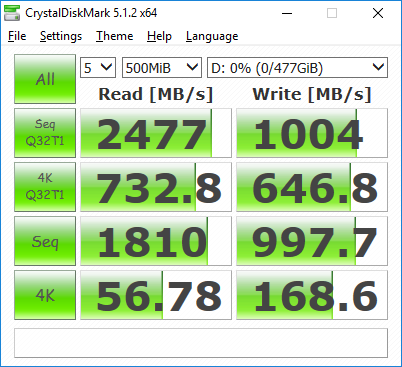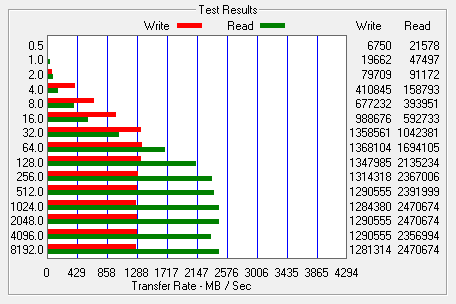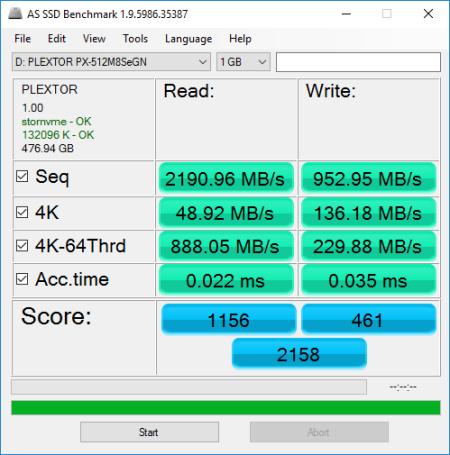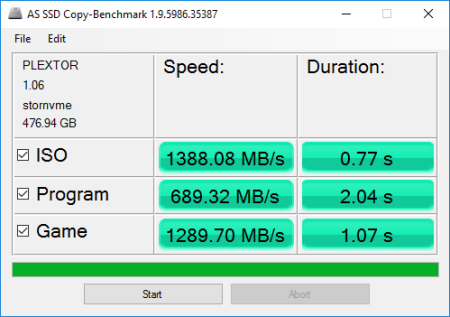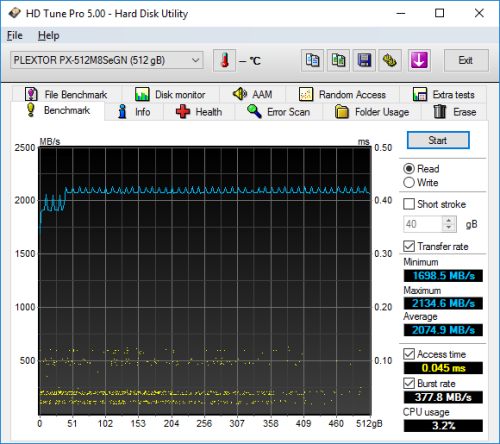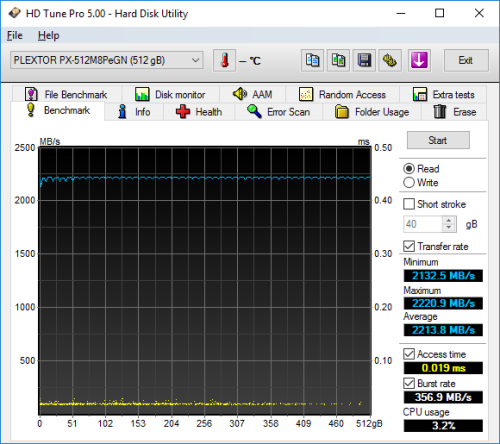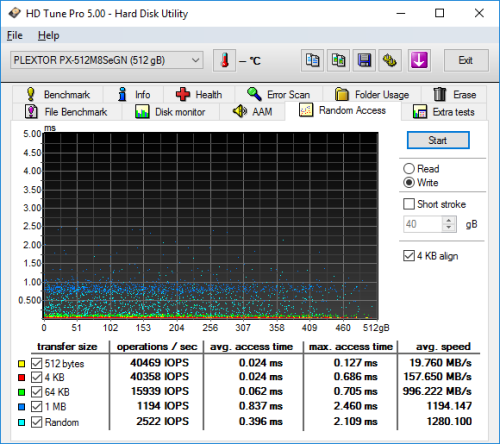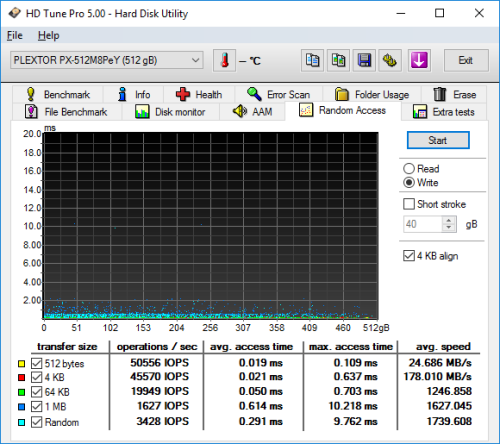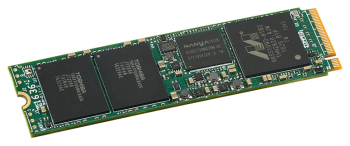

Model: Plextor M8Se 512GB M.2 NVMe PCIe Solid State Drive
Manufacturer: Plextor
Provided By: Plextor LLC
As one of the biggest names in the storage industry, Plextor doesn't need much of an introduction. For nearly twenty years, they've produced some of the best optical drives the industry has seen. Known the world over for their quality, performance, and features, these drives have become favorites among consumers and professionals alike. Today, Plextor continues to lead the way by bringing cutting edge storage technologies to market. Along with an assortment of high-performance DVD and Blu-ray drives, the company offers a growing number of solid state drives.
 At this year's Consumer Electronics Show (CES), Plextor unveiled its first TLC NAND-based PCIe SSD, the M8Se. Targeted at entry-level gamers, this M.2 form factor drive is powered by Marvell's 88SS1093 "Eldora" controller and is available with up to 1TB of Toshiba's 15nm TLC NAND flash. To compensate for the slow write speeds typically associated with TLC NAND, the M8Se uses Plextor's exclusive PlexNitro cache acceleration technology to optimize performance without taking up any space on the drive. The M8Se is also equipped with a PCIe Gen3 x4 NVMe 1.2 interface to provide higher bandwidth and lower latency than SATA SSDs.
At this year's Consumer Electronics Show (CES), Plextor unveiled its first TLC NAND-based PCIe SSD, the M8Se. Targeted at entry-level gamers, this M.2 form factor drive is powered by Marvell's 88SS1093 "Eldora" controller and is available with up to 1TB of Toshiba's 15nm TLC NAND flash. To compensate for the slow write speeds typically associated with TLC NAND, the M8Se uses Plextor's exclusive PlexNitro cache acceleration technology to optimize performance without taking up any space on the drive. The M8Se is also equipped with a PCIe Gen3 x4 NVMe 1.2 interface to provide higher bandwidth and lower latency than SATA SSDs.
The M8Se is offered in a wide range of capacities and not one or two, but three different configurations. The drive is available by itself in the M.2 2280 form factor (M8SeGN), with a small aluminum heatsink (M8SeG) and as a PCIe add-in card (M8SeY) that's equipped with an extra large heatsink and LED lighting. For this review, Plextor sent us the bare 512GB M.2 version of the drive, which is capable of delivering up to 2,450 MB/s sequential read and 1,000 MB/s sequential write speeds along with up to 210,000 random read and 175,000 random write IOPS.
| Plextor M8Se 512GB M.2 PCIe NVMe Solid State Drive | |||||||||||||||||||||||||||||||||||||||
General Specifications
Performance
Environment and Reliability
Dimensions and Weight
Other Features
|
Needless to say, this is only a taste of what the M8Se has to offer. To give you an idea of what to expect, we'll take a closer look at Plextor's new NVMe SSD and then see how well it performs. Does the M8Se have what it takes? More importantly, is it the best bang for your buck? Keep reading as we find out.
The M.2 2280 version of the M8Se comes packaged in an eye catching blue box. The front advertises key features like the drive's 512GB capacity, support for NVMe and Plextor's PlexNitro, True Speed and True Protect technologies. The back of the box provides a bit more information regarding the M8Se's specifications and features.
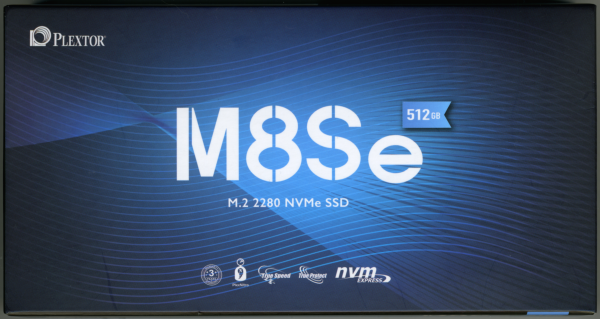

Inside the box, you'll find a clamshell case containing the M8Se and a small mounting screw. I was a bit surprised to see that Plextor did not include any documentation with the drive.

Physical Features:
The M8Se uses the 2280 form factor for M.2 (NGFF) SSDs. It measures 80 x 22 x 2.3 mm and tips the scales at a mere 10g. The drive also has an "M key" edge connector which provides PCIe SSDs with up to 4x lanes of bandwidth.
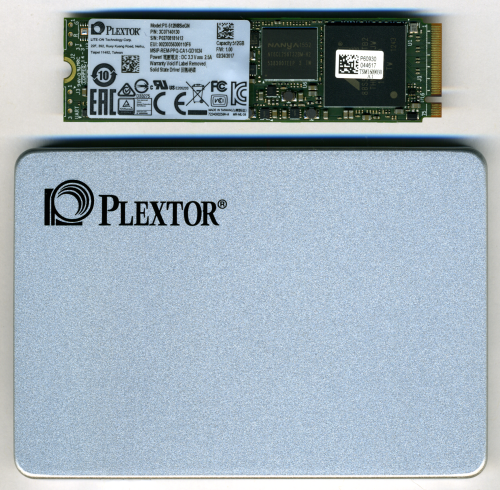
Like the M8Pe, the M8Se uses Marvell's 88SS1093 controller. This 8 channel, PCIe Gen 3 x4 NVMe SSD controller is equipped with three ARM Cortex R5 cores and features support for 15nm TLC/MLC/SLC and 3D NAND. The 88SS1093 also integrates Marvell’s third generation NANDEdge error-correcting, low-density parity check (LDPC) technology for higher reliability and endurance.


For the 512GB version of the M8Se, Plextor used Toshiba's 15nm "Super High Performance" TLC NAND flash. Looking at the pictures above, you can see that there are two 256GB NAND flash packages on the top of the PCB. The drive also has a single NANYA 1GB LPDDR3 DRAM memory chip that is used for caching.
The test system used in this review is equipped with an Intel Core i7-6700K CPU, GIGABYTE GA-Z170X-UD3 motherboard, 32GB (16GB x 2) of Crucial Ballistix Sport LT DDR4 memory, Plextor SU800 512GB SSD and a GIGABYTE GeForce GTX 1060 WINDFORCE OC 6G graphics card. For the operating system, I installed a fresh copy of Windows 10 Enterprise.
To test the performance of Plextor's M8Se SSD, I ran a series of benchmarks using CrystalDiskMark, HD Tach RW, ATTO Disk Benchmark, AS SSD, HD Tune Pro, Anvil's Storage Utilities, Iometer and PCMark 8. For comparison, I've also included test results from the Patriot Hellfire, Plextor M8Pe, ADATA XPG SX8000, Samsung 960 PRO, Toshiba OCZ RD400, Samsung 950 PRO, Toshiba OCZ VX500, ADATA Ultimate SU800, Plextor S2C, Crucial M300, Plextor M7V, PNY CS1311, OCZ Trion 150, PNY CS2211, Plextor M6V, Crucial BX200, OCZ Trion 100, Kingston HyperX Savage, Crucial MX200, OCZ Vector 180, Samsung SSD 850 EVO and Samsung SSD 850 PRO.

As I mentioned earlier, the M8Se is based on Marvell's 88SS1093 controller chip. Looking at the screenshot above, you can see that it performs equally well with both incompressible (0%) and compressible (100%) data.
CrystalDiskMark 5.1.2:
First, I ran a few quick tests using CrystalDiskMark. This benchmark tool measures the performance of a storage device by testing its sequential read and write speeds as well as its random read and write speeds using blocks 512K and 4K in size.
According to Plextor, the 512GB version of the M8Se is capable of reading at 2,450 MB/s and writing at 1,000 MB/s. Looking at the screenshot above, you can see that the drive had no problems reaching these speeds in CrystalDiskMark's sequential read and write tests.
HD Tach RW 3.0.4.0:
Next, I used HD Tach to test the M8Se's read, write and burst speeds as well as its seek times and CPU usage.

Plextor M8Se 512GB
Looking at the screenshot above, you can see that the M8Se had average read and write speeds of 1387.7 MB/s and 434.4 MB/s respectively, as well as a burst speed of 483.0 MB/s. The screenshot also shows that, like most other TLC-based SSDs, the M8Se uses some sort of SLC caching. The drive starts writing at about 720 MB/s and then drops to about 400 MB/s when the write operation exceeds the size of the cache. The cache on the 512GB version of the S2C is also surprisingly small. It appears to use about 1% of the drive's total capacity, which is about 5GB.
ATTO Disk Benchmark 2.46:
I also used ATTO Disk Benchmark to test the M8Se's sequential read and write speeds. The tests are run using blocks ranging in size from 0.5KB to 8192KB and the total length set to 256MB.
When tested with ATTO, the M8Se's read speeds topped out at about 2,481 MB/s and its write speeds at 1,005 MB/s.
AS SSD:
AS SSD is a relatively new benchmark designed specifically for solid state drives. The application contains five synthetic tests used to determine the sequential and random read and write performance of a drive.
AS SSD also includes a copy benchmark. This test copies an ISO (two large files), program (many small files) and game (small and large files), returning the speed and duration of each.
HD Tune Pro 5.00:
Next, I ran a series of tests using HD Tune Pro. This hard disk utility measures a drive's performance by testing its sequential read and write speeds as well as its access time, burst rate and CPU usage. For this review, I'm also going to use it to benchmark the M8Pe's random read and write speeds, random access times and the number of operations per second.
The M8Se performed relatively well when benchmarked with HD Tune. The drive had average read and write speeds of 2074.9 MB/s and 463.5 MB/s, respectively, and a burst rate of about 377.8 MB/s when reading.
The M8Se didn't disappoint when doing random reads and writes. When writing 4KB blocks, the drive reached 40,358 IOPS and had an average speed of 157.650 MB/s. It was even faster when reading, reaching 44,000 IOPS with an average speed of 171.877 MB/s.
Anvil's Storage Utilities:
Anvil's Storage Utilities is another benchmark designed with SSDs in mind. The standard storage benchmark measures a drive's performance by testing its transfer speeds, access times and IOPS.

Iometer:
Lastly, I ran a series of tests using Iometer. This tool can be configured to benchmark a number of things. In this case, I used it to measure the M8Se's read and write speeds and the number of operations per second. The tests were run using random bytes and a queue depth of 3.

The M8Se's performance was hit and miss when tested with Iometer. While the drive was able to read at a respectable 2310.81 MB/s, its sequential write speed averaged out at only 472.68 MB/s.

While faster than the SATA SSDs, the M8Se lagged behind the other PCIe SSDs when doing random reads and writes. In our tests, the drive was able to read at 215.13 MB/s and write at 409.15 MB/s.

According to Plextor, the 512GB M8Se is capable of up to 210,000 IOPS when reading and 175,000 IOPS when writing 4K blocks. In our tests, the drive reached 55,072 random read IOPS and 104,743 random write IOPS. As with most drives, the M8Se performed better at higher queue depths. With the queue depth set to 32, it reached 243,207 random read IOPS and 109,328 random write IOPS.
PCMark 8 - Storage Test:
PCMark 8 is a complete benchmark for Windows. It includes five benchmark tests, each designed around a specific scenario. The storage benchmark measures drive performance using real-world traces recorded from Adobe Creative Suite, Microsoft Office and a selection of popular games.
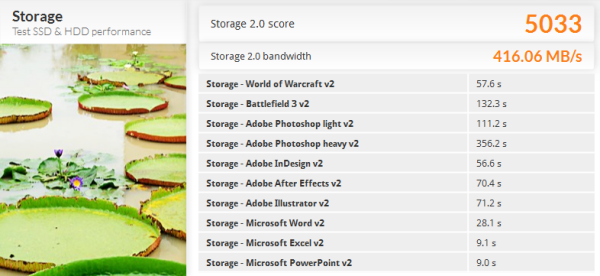
PCMark 8 also includes a consistency test which measures the performance consistency and degradation tendency of a storage system. The test reports the performance level at the start, the degraded steady-state and the recovered state as well as the number of iterations required to reach the degraded state and the recovered state. For this test, we are focusing on the Adobe Photoshop (Heavy) trace and will look at both the bandwidth and latency of the drive


The M8Se yielded some pretty odd results in this test. Throughout all three phases, the bandwidth jumped from about 50 MB/s up to as high as 850 MB/s and then back down again. I reached out to Plextor to see if they had any idea why this was happening, but at this time we have not gotten an answer from their engineers. The only explanation that I can think of is that this is due to the PlexNitro cache filling up and then recovering.
TRIM Performance:
While SSD's offer many benefits, there are some downsides to using flash memory. One of the biggest issues people run into is performance degradation. Over time, an SSD will run out of fresh blocks and will have to write over data the file system has marked as deleted. This procedure is very complicated and can slow an SSD's write speeds considerably.
To fix this problem, most manufacturers have added TRIM support to their SSDs. The TRIM command allows an operating system, such as Windows 7, to tell an SSD which data blocks are no longer in use. Using this information, the drive pro-actively erases these blocks and adds them to the free block pool.

To test the M8Se's TRIM and garbage collection functions, I first put the drive in a "dirty" state. I used Iometer to fill the entire drive and then ran a random write test for 30 minutes. Looking at the screenshot below, you can see that the M8Se's average read and write speeds dropped to 140.7 MB/s and 477.4 MB/s, respectively.

Plextor M8Se - Dirty
To see how well the M8Se could recover, I let the computer sit for about 30 minutes and then reran the test. The drive's average write speed climbed up to 479.3 MB/s. However, its read speed lagged behind, averaging out at only 271.0 MB/s.
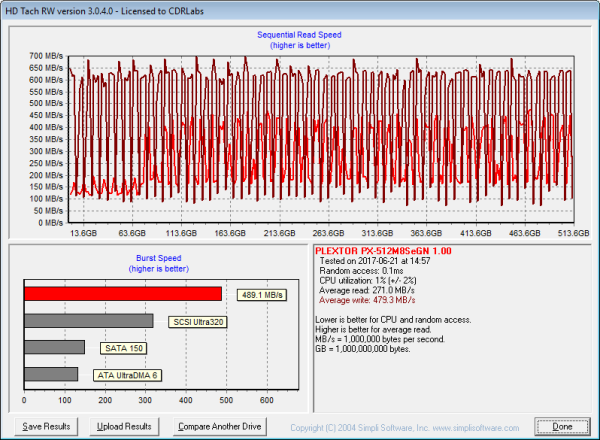
Plextor M8Se - After TRIM
Lastly, I used Parted Magic to perform a secure erase on the M8Se. With the drive wiped clean, it had average read and write speeds of 1393.2 MB/s and 629.0 MB/s, respectively.

Plextor M8Se - Secure Erased
Final Thoughts:
The Plextor M8Se is a great choice for the budget-conscious gamer looking to put an NVMe SSD in their notebook or desktop computer. Available with or without a heatsink, this M.2 form factor SSD is powered by Marvell's 88SS1093 controller and is available with up to 1TB of Toshiba's 15nm TLC NAND flash. Combine this with Plextor's PlexNitro technology and a PCIe Gen3 x4 NVMe 1.2 interface and you have a drive capable of delivering four times the read and twice the write performance of your average SATA 6Gb/s SSD. In our sequential read and write tests, the M8Se was able to read at speeds as high as 2,481 MB/s and write at speeds in excess of 1,004 MB/s. The drive also did relatively well in our random write tests, producing more than 104,000 IOPS at low queue depths.
While Plextor's PlexNitro technology works well under normal workloads, it does have its limitations. If you have a heavy workload, where a consecutive write operation exceeds the size of the SLC cache, the M8Se's write speed drops to non-accelerated levels. I also found this cache to be quite small. With the 512GB version of the M8Se I wasn't able to write more than about 5GB worth of data before it filled. Given, this won't be an issue for the consumer or gamer looking to speed up load times, but, if you have heavier workloads, you may want to consider Plextor's M8Pe SSD.
The M8Se is available now in 128GB, 256GB, 512GB and 1TB capacities. However, here in the US, Newegg is the only retailer with the drive in stock and they appear to be charging a premium for it. They currently have the M8Se priced the same or, in some cases, higher than the better performing M8Pe. According to Plextor, the actual suggested retail prices range from about $77 up to $462 with the M.2 version reviewed here going for about $240. Needless to say, you'll want to wait for Newegg to lower their prices (Update: Newegg has lowered the price of the M8Se) or wait for retailers like Amazon to get the M8Se in stock.

Highs:
- PCIe 3.0 x4 interface with NVMe protocol
- Equipped with Toshiba TLC NAND
- Available in 128GB, 256GB, 512GB and 1TB capacities
- Good sequential and random read and write performance
- PlexNitro technology optimizes performance without taking up SSD space
- Supports True Speed and True Protect technologies
- M.2 2280 and HHHL PCIe form factors
- Large DRAM cache
- Competitively priced
- 3 year warranty
Lows:
- Write speed drops when SLC cache is full
- SLC cache is small
- Not supported by Plextor's PlexTool software
- Does not support hardware based encryption
